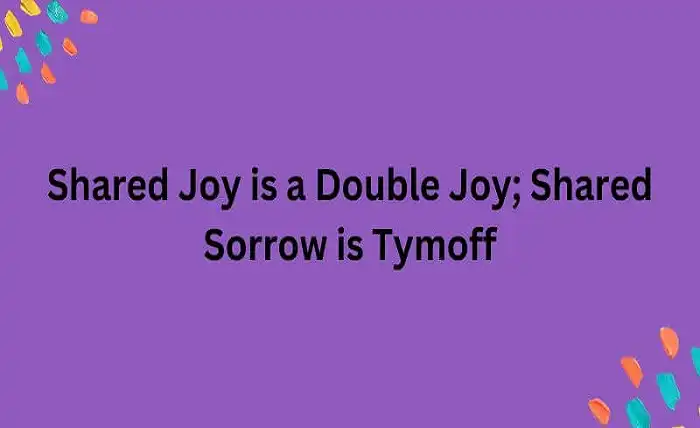shared joy is a double joy; shared sorrow is tymoff

Shared Joy Is A Double Joy; Shared Sorrow Is Tymoff. It touches on a global reality that is profoundly felt by all people. Sharing personal victories or losses significantly alters our emotional landscape, fostering connection and understanding among individuals. This blog delves into the intricate dynamics of shared emotions, exploring how it bolsters resilience and adds meaning.
The Psychological Foundations of Shared Emotions
Our innate desire to connect with others is the cornerstone of shared emotions. This fundamental need drives us to seek understanding and shared joy is a double joy; shared sorrow is tymoff empathy, establishing a common ground for both joy and sorrow. Psychological studies underscore the significant impact that sharing emotions has on our emotional intensity.
Sharing happiness amplifies the feeling, enriching the experience, rendering moments more vivid and unforgettable. On the other hand, sharing our sorrows with others enables us to share the emotional burden, so reducing its burden. This interaction serves as an example of how important social connectivity is in influencing our emotional experiences.
Sharing feelings builds a psychological channel, strengthening emotional defenses, enhancing happiness, and providing comfort in adversity. This interconnectedness, inherent in our psychological structure, demonstrates how our emotional shared joy is a double joy; shared sorrow is tymoff health is influenced by shared experiences.
The Role of Social Support in Amplifying Joy
Sharing joy with others enhances happiness through support and acknowledgment from our social circles, amplifying the experience. This phenomenon is rooted in the positive reinforcement that comes from others’ reactions.
Their smiles, congratulations, and shared excitement act as mirrors, reflecting our joy back to us and intensifying it. This mutual exchange doesn’t just deepen our immediate sense of happiness; it also solidifies our connections with those around us. Through this process, joy becomes more than a fleeting emotion; it transforms into a shared joy is a double joy; shared sorrow is tymoff shared experience that bonds individuals and creates memories that last.
Participating in communal celebrations or sharing good news strengthens social bonds, demonstrating that shared joy multiplies happiness. This interplay between personal happiness and social support showcases the intrinsic link between our emotional well-being and the community we keep.
Mitigating Sorrow Through Shared Experiences
Opening up about our difficulties and sharing our stories of sorrow can significantly lighten our emotional burdens. This action invites a compassionate response from those around us, enabling a connection that goes beyond surface-level interactions.
Received empathy and understanding not only soothe pain but also strengthen community bonds, offering invaluable support in adversity. In the shared space of vulnerability, sorrow morphs from an isolating experience into a collective path towards recovery. It exemplifies how human connection has the capacity to turn pain on an individual basis into collective resilience.
Sharing promotes healing and cultivates a supportive, open atmosphere, encouraging others to discuss their losses more freely. This group approach to grieving and adverysity underscores the power of solidarity, demonstrating that shared grief lessens its intensity, easing the journey through hardship.
The Importance of Vulnerability in Sharing
Sharing highs and lows hinges on vulnerability, requiring strength and courage at its core. To truly share is to let down our guards and present our most authentic selves to others, a gesture that not only fosters personal growth but also paves the way for more meaningful connections.
Transparency reveals our true selves, inviting others to share experiences and be inspired, fostering deeper, more empathetic relationships. We find the common threads that unite us and emphasize our shared humanity during these true moments of sharing.
Acting with such honesty requires trust in shared compassion and resilience within our connections. Once built, this trust has the power to change the way we interact, enhancing the vibrancy of every shared joy and easing the burden of every shared grief. Vulnerability allows our relationships to reach their full potential and creates a space where real understanding and support may grow.
The Impact of Sharing on Mental Health
Accepting and valuing the sharing of emotions both happy and sad is essential to maintaining mental health. This technique protects against the trap of solitude while also promoting pleasant feelings and a resilient attitude toward life’s challenges. When we open up and allow our pleasures to magnify and our tragedies to lessen through shared experiences, we access a potent mechanism of emotional regulation within our communities.
Mutually beneficial interactions within community reduce stress impact and lower mental health issues likelihood significantly. Moreover, the camaraderie fostered by common experiences promotes a group approach to problem-solving, offering people a wide range of viewpoints and coping mechanisms.
Dynamic conversations enhance emotional intelligence, equipping us to navigate the complexity of human emotions more effectively. Sharing, a fundamental yet profound act, highlights the significance of connection and the power inherent in shared vulnerability. It is thus a cornerstone for establishing and preserving mental health.
Cultivating a Culture of Sharing in Communities
To foster safety and transparency, celebrating victories and sharing setbacks is crucial for community culture promotion. Fostering such environments involves implementing programs and practices prioritizing empathy, active listening, and unwavering support across workplaces, schools, and neighborhoods.
Encouraging regular community gatherings or meetings where individuals can share their experiences and feelings helps normalize open communication. Educational workshops that teach emotional literacy and communication skills can equip members with the tools needed to express themselves more effectively and support others empathetically.
Establishing community support networks based on shared experiences offers structured outlets for expressing and receiving support effectively. These collective efforts not only deepen individual connections but also strengthen the communal bonds, making the community a cornerstone of emotional support and resilience. Deliberate community actions foster mutual understanding, shared growth, showcasing the profound benefits of joy and sorrow sharing culture.
Practical Tips for Sharing Joy and Sorrow
Navigating the waters of emotional sharing can be enriching yet complex. Here are succinct strategies to help you share more effectively:
– Prioritize active listening, ensuring you’re fully present and empathetic to others’ experiences. This foundational skill paves the way for deeper connection.
– Communicate your own emotions with clarity, utilizing “I” statements to express how you feel in a manner that’s direct yet considerate of the listener’s feelings.
– Cultivate your social circles with care, choosing environments and relationships that foster openness and mutual support. These spaces can significantly impact how freely you express yourself.
– Don’t overlook the importance of celebrating life’s smaller joys. These moments, though seemingly trivial, can enhance bonds and promote a positive outlook.
– Never forget that just being there may be a very effective kind of assistance. A person going through highs and lows can find great consolation in having a shoulder to cry on or a listening ear.
Using these suggestions can improve the way we express and deal with our feelings, which can result in deeper, more encouraging connections.
The Ripple Effect of Shared Emotions
Beyond merely bringing people together, the phenomenon of shared emotions has the ability to spark good change in larger societies. People who freely express their happiness can act as a source of inspiration and hope for others, fostering an environment that is resilient and upbeat.
Encouraging open grief expression fosters understanding and group compassion, promoting mutual support during times of need. Whether they are based in joy or sorrow, these emotional interactions help people feel more connected to one another and more understanding of one another.
They emphasize how important emotional unity is to creating communities that are more resilient and caring. This connection opens the door for a more compassionate global society while also improving organizations’ ability to deal with life’s ups and downs. Sharing reveals the broad impact of our emotional landscapes, fostering greater awareness and support among individuals and groups.
3 FAQs About – Shared Joy Is A Double Joy; Shared Sorrow Is Tymoff
Q: What does it mean that “shared joy is a double joy?
A: This proverb implies that our happiness is multiplied when we share it with others. Because delight is experienced in tandem with another person, it becomes double pleasurable and memorable.
Q: How can sharing sorrow help alleviate it?
A: Sharing sorrows lightens emotional burdens, making experiences easier to bear by distributing the weight among others. Our sorrows can feel less intense and more manageable when we receive the same in return—support, empathy, and understanding.
Q: Why is it crucial to be vulnerable when discussing happiness and grief?
A: Being vulnerable is important because it makes it possible for real connections to happen. We meaningfully welcome people into our lives when we are forthright and honest about our emotions. Building trust and understanding fosters deeper bonds, enabling open and powerful communication of joys and sorrows.
Final Thoughts To – Shared Joy Is A Double Joy; Shared Sorrow Is Tymoff
Joy and sorrow interweave as threads in the tapestry of human experience, adding depth and color to our lives. This examination of shared emotions highlights our intrinsic need for connection, which is a basic quality of humanity. Sharing spreads suffering, doubles pleasures, showcasing empathy’s transformative power through community support and connection.
In life’s highs and lows, embracing vulnerability with those nearby holds profound significance and connection. By cultivating atmospheres of openness and trust, we can create more robust and resilient communities, ensuring everyone feels seen, heard, and supported. Through this act, we access the collective human experience, enriching and uplifting our individual paths together.
In our lives and globally, listening, empathizing, and being present spark profound transformation through small acts of kindness. Thus, let’s make a commitment to sharing more going forward because doing so not only brings us joy and comfort, but also captures the very spirit of what it means to be human.

